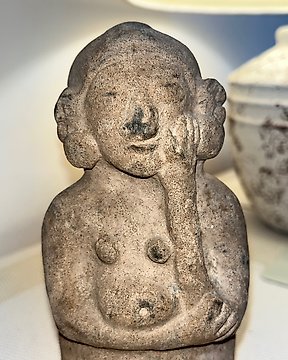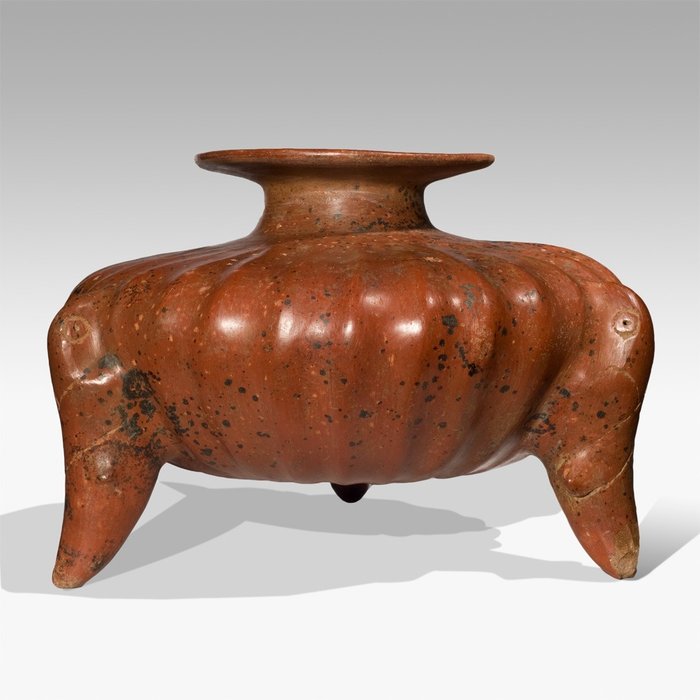
Tumaco-Tolita Terracota Mujer embarazada en posición de pensar - 23 cm
N.º 83275829

N.º 83275829

Pumpkin-shaped vessel or jar tripod with bird-shaped feet
CULTURE: Colima, Mexico
PERIOD: 200 B.C. - 200 A.D.
MATERIAL: Terracotta
DIMENSIONS: 34 cm diameter, 23 cm height.
PROVENANCE: American private collection. With Spanish Export license.
CONSERVATION: Perfect condition, intact.
DESCRIPTION:
The piece is a round-shaped vessel supported by three zoomorphic feet that present the appearance of small parrots or cockatoos. The vessel has the shape of a gourd, with the striated appearance that characterizes this fruit. The neck is short and its mouth opens pronouncedly flat.
The cultures of the west of Mexico stand out above other pre-Columbian cultures for their vast production of ceramics of unequalled quality and variety. These pieces were to form part of the grave goods of a deceased person, and it is for this reason that they have been found almost exclusively in tombs. This factor has been decisive for their conservation up to the present time, and has meant that they are practically all intact and looking much as when they were originally produced.
The spectrum of types and motives represented in the ceramics of the cultures of Colima, Nayarit and Jalisco is very wide. The pieces have been of great use in widening knowledge of the traditions and practices of these Mesoamerican peoples.
BIBLIOGRAPHY:
- AA.VV, Sculpture of Ancient West Mexico, Los Angeles County Museum of Art, 1970.
- AA.VV, Trésors de la céramique précolombienne dans les collections Barbier-Mueller, 2003.
- VON WINNING, Hasso, Pre-Columbian Art of Mexico and Central America.
- TOWNSEND, Richard F. Ancient west Mexico. Art and archaeology of the unknown past. Thames & Hudson, Chicago, 1998.
- BALUTET, Nicolás. La importancia de los enanos en el mundo maya precolombino. Instituto iberoamericano de Indiana, nº 26, 2009.
- VÉRUT, DOMINIQUE D. Precolombian dermatology & cosmetology in Mexico. Schering corporation U.S.A, 1973.
Notes:
- The piece includes authenticity certificate.
- The piece includes Spanish Export License (Passport for European Union). NO TAXES.
- According to Spanish legislation, items sent outside the European Union are subject to export taxes and will be added to the invoice, at the buyer's expense. These export fees are fixed on the final auction price and the tax rate is not applied directly on the total value of the item to be exported, but rather the different percentages by sections are applied to it:
- Up to 6,000 euros: 5%.
- From 6.001 to 60.000 euros: 10%.
This export permit application process can take between 1-2 months maximum.
- The seller guarantees that he acquired this piece according to all national and international laws related to the ownership of cultural property. Provenance statement seen by Catawiki.
Cómo comprar en Catawiki
1. Descubre algo especial
2. Haz la puja más alta
3. Paga de manera segura